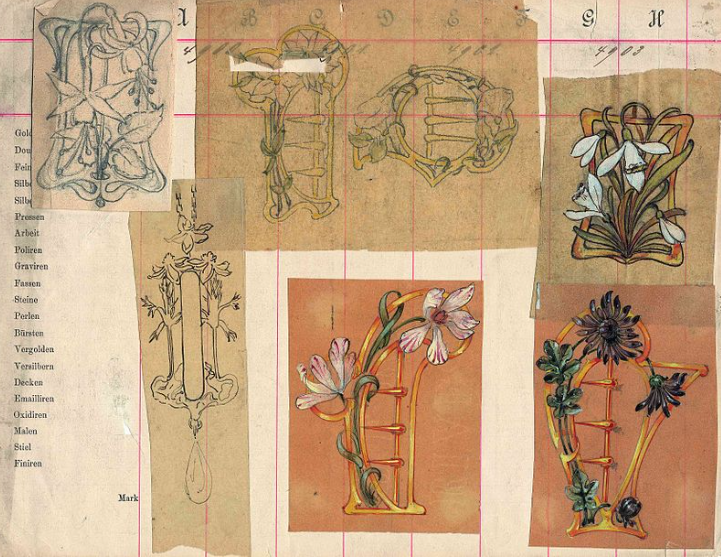#History #Victor #Mayer #Jewellery #Fabergé #Connection
.
Victor Mayer was born in 1857. His portrait is courtesy of Victor Mayer GmbH & Co KG Pforzheim. He trained as a steel engraver and also as an artist. In 1877 he commenced his studies at the Grand Ducal School of Arts and Crafts. It was during his studies at this institution he became known as a highly talented draughtsman. Whilst studying in Vienna he also worked as an engraver to pay for his tuition. His training involved perfecting the art of guilloche engraving and enamelling. He was to become one of the finest jewellers of his time. His desire to educate himself and hone his talents left very little spare time, as even when he was not working or studying he would visit museums and libraries to gain inspiration, knowledge and also to keep up to date with the latest techniques and tools of his trade. After completing his studies he worked for several Viennese jewellery concerns. The image above shows him on the day he wed Lina Niemand who was born in Baden Baden. The portrait was taken by A. Schmidt whose photography business was located in Mayer’s home town of Pforzheim. He is thought to have wed in the same year as he founded his jewellery concern, which was 1890. The other co-founder was Hermann Vogel, who left the partnership in 1895.
VICTOR MAYER BELT BUCKLES & JEWELLERY DESIGNS C. 1903
Source: Victor Mayer GmbH & Co KG Pforzheim
Not only was Mayer a successful businessman who would go on to work for Faberge, he was also a great patron. He would nurture the talents of poverty stricken artists and provide them with much needed work. The great artist Anton Krautheimer was one such artist. Mayer commissioned Krautheimer to produce jewellery designs and steel engravings. These commissions supported Anton Krautheimer through his hardest times when he found work hard to find.
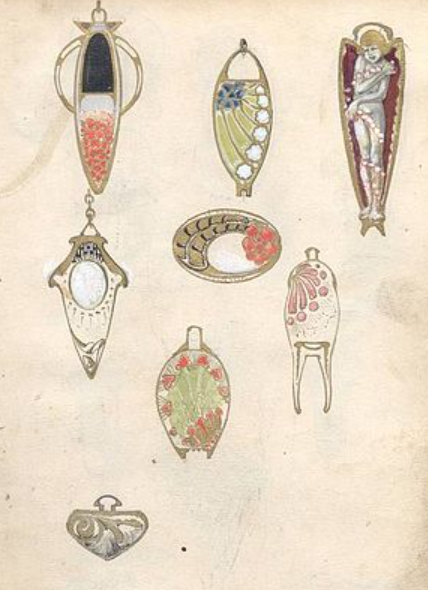
ANTON KRAUTHEIMER DRAWINGS FOR VICTOR MAYER
Source: Victor Mayer GmbH & Co KG Pforzheim
Anton Krautheimer would go on to become one of the most celebrated sculptors. In 1908 he won the prestigious Rome Prize. Victor Mayer was so delighted that he wrote to Krautheimer to congratulate him. This success prompted Anton to set up his own studio in Munich as an independent sculptor. 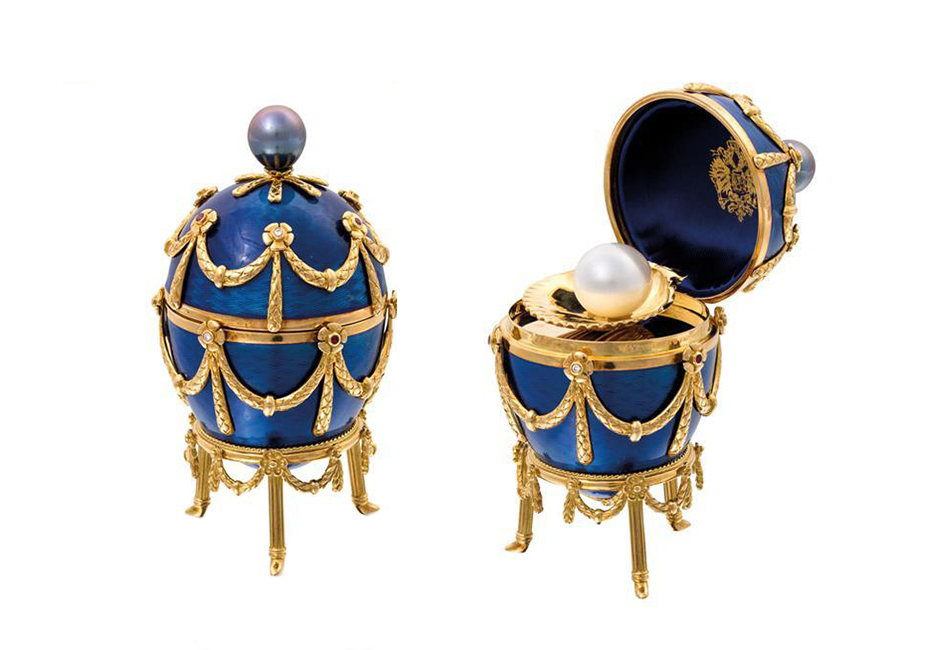
VICTOR MAYER FOR FABERGÉ
© Sotherby’s
The fine silver and enamelled pieces created by Victor Mayer were so opulent that they were comparable to pieces crafted at the court of the Tzar Nicholas. As we can see in the image shown above his work is the most superb anyone could imagine. The Easter egg is crafted from 18ct gold, enamel, gems and south sea pearls – closed and open views.

THE HOUSE OF FABERGÉ MOSCOW
Gustav Fabergé was a Baltic goldsmith and the father of Peter Carl Fabergé. The most trusted workmaster of the jewellery concern was Hiskias Pendin. He was given the task of mentoring Peter Carl and training him to catalogue and restore objects stored at the Hermitage during the 1870s. This training took over a decade to complete. In 1881 the business moved to larger premises at 16/18 Bolshaya Morskaya in St.Petersburg.

The Fabergé headquarters located at 16/18 Bolshaya Morskaya, St Petersburg are shown above. The building comprised retail premises, workshops and an art studio. This building served as the head office for Fabergé and it also contained Carl Fabergé’s fifteen room apartment. Hiskias Pendin died in 1882 and so Peter Carl Fabergé took responsibility for running the company. He was awarded the title Master Goldsmith, which permitted him to use his own hallmark in addition to that of the firm. The distinctive hallmark of Victor Mayer is shown below.

By 1885 his brother Agathon Fabergé had joined the firm. The brothers formed a formidable team. In 1882 their fabulous creations caused a sensation at the Pan-Russian Exhibition held in Moscow. Peter Carl was awarded the gold medal. The Tsar was so impressed by his recreation of a 4th century BC gold bangle that he declared he could not differentiate between it and the ancient original piece. As a result of this Fabergé creations were displayed in the Hermitage and the Tsar granted valuable commissions to Fabergé. One of which resulted in the creation of what is said to be the first Fabergé egg, known as the Jewelled Hen Egg. This egg was gifted to the Tsarina on 24 March 1885. This piece delighted the Tsarina so much that the Tsar appointed Fabergé the title by special appointment to the Imperial Crown in the same year. Each year Fabergé was commissioned to create another Easter egg. The Russian Imperial family had experienced assassination attempts and the Tsar sought ways to distract his wife from worrying. She was overjoyed to see a different Fabergé Easter egg every year. Each egg contained an exquisitely beautiful surprise inside. The most famous of the Fabergé eggs is The Imperial Coronation Egg.

THE IMPERIAL CORONATION EGG
© Miguel Hermoso Cuesta
The name of Fabergé has been synonymous with the opulence seen in the court of the Russian Tsar since the appointment of Peter Carl Fabergé to the role of official goldsmith to the Russian Imperial Court. Fantastical creations made from precious metals, jewels and superbly rendered enamels ensured the brand world wide fame.
The reputation of Victor Mayer also spread far and wide. From the earliest days of opening his business Mayer would travel to see his customers. His work took him to Berlin, Paris, London, St. Petersburg, Vienna, Warsaw and Cairo. The firm also had a wealthy clientele in Switzerland. Victor and Lina had six children. The three daughters were named Marie, Else and Erna. His three sons were trained and educated to follow in their father’s footsteps. Victor Junior studied in Paris, London and Madrid. His twin sons Julius and Oskar attended the Grand Ducal School of Arts & Crafts.
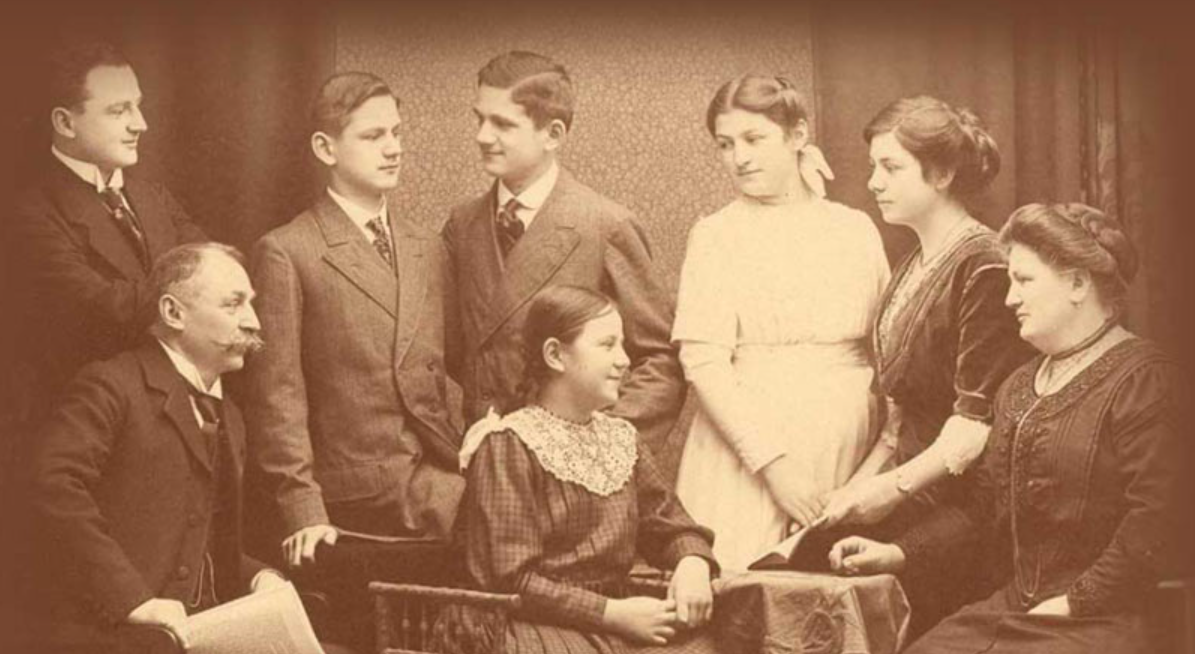
VICTOR AND LINA MAYER WITH THEIR CHILDREN
Source: Victor Mayer GmbH & Co KG Pforzheim
Sadly WWI claimed two of Victor’s sons. Victor Junior was called up in 1914. Shortly after this Julius volunteered to fight. Both young men died in action. Oskar had never been in good health and his father forbade him from volunteering due to his illnesses. Oskar and his three sisters all rallied around their parents and helped the firm to continue to produce fine work after the war. Some of the collections were inspired by the terrible losses suffered in WWI. Collections of mourning and remembrance jewellery, especially lockets were launched. Some of the designs are shown in the next image.
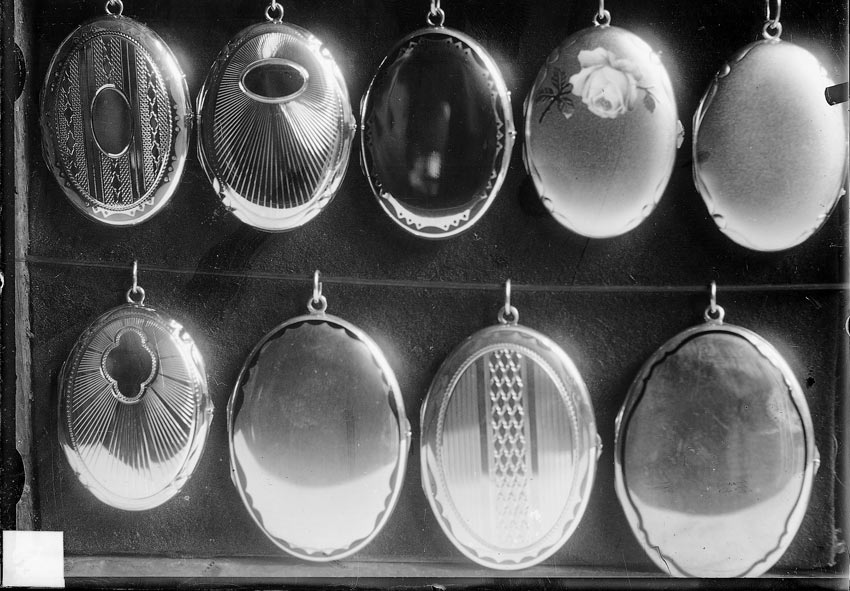
Source: Victor Mayer GmbH & Co KG Pforzheim
After WWI the Art Nouveau period was coming to a close and the era of Art Deco was about to begin. Mayer was in his sixties and despite his age he embraced the challenges of this wonderfully inspiring era. Splendid Art Deco creations were crafted by this firm. These pieces included sublime Cubist inspired vanities which are extremely difficult to find. Here is one Cubist inspired vanity box.

VICTOR MAYER SILVER AND ENAMEL VANITY
More hallmarked silver and enamel vanities.
This exquisitely beautiful and stylish Art Deco vanity was made by Victor Mayer. This firm was located in Pforzheim – the gateway to the Black Forest. This city is famous as the centre of jewellery making – so much so that it was known colloquially as Goldstadt (‘Golden City’). The name of Victor Mayer is well known for its luxurious ultra vanities, high end jewellery and the exceptionally skilled workmanship as we see in this adorable Art Deco powder compact.This compact is made from higher grade silver than sterling. The case is fully hallmarked 935 silver and bears the maker’s mark too. The lid has the most stylish Art Deco design of two royal blue enamel panels and in the middle light cadmium red enamel divided by two 935 silver borders. This supremely stylish accessory is decorated with guilloche engraving on all sides and the base. A tiny double thumb catch ensures ease of opening.
From 1925 until 2009 the company continued to produce Fabergé jewelry under licence from Unilever, until the brand licence was sold.
Maria married the banker Edmund Mohr who became a co-owner of the company in 1925. In the mid 1920s the company began to manufacture powder compacts, cigarette cases, gentlemen’s accessories, photo frames and all manner of beautifully enamelled boxes.
In 1932 Victor Mayer withdrew from the business and handed over his shares in equal parts to his only remaining son Oskar Mayer and his son in law Edmund Mohr. Oskar Mayer and Edmund Mohr were co-owners of the company until 1965. In this year two grandsons of Victor Mayer, Dr. Herbert Mohr-Mayer and his cousin Hubert Mayer, took over the running of the firm.
During WWII the whole family and extended Mohr family distanced themselves from the Nazi party. During the war the production of jewellery and accessories ceased. Some military medals were commissioned by the Wehrmacht. It must have seemed like a miracle when the whole of Pforzheim was destroyed in a devastating bombing raid when the family and workers found that the factory was still standing. The family gave over much of the factory premises to house local families who had been made homeless.
A year later (1946) when the war was over, jewellery production began again. This was the year the founder, Victor Mayer passed away peacefully in his home town of Pforzheim.
Victor Mayer is one of the few companies who practice the art of guilloche engraving and enamelling in the twenty-first century. Whilst studying art history Dr. Herbert Mohr developed a keen passion for the artistic craftsmanship seen in the court of the Tsar of Russia. Paying tribute to Victor Mayer and Fabergé, Dr Mohr managed the launch of the Esprit de Fabergé collection in the early 1980s.
After the fall of the Tsar the Fabergé brand name had almost laid dormant and it had been sold to an American company.

VICTOR MAYER FABERGÉ EGG
Source: Victor Mayer GmbH & Co KG Pforzheim
Victor Mayer GmbH & Co was appointed the sole authorised Fabergé workmaster in 1989 by way of the worldwide exclusive licence. Only Victor Mayer GmbH & Co was permitted to create pieces stamped with the FABERGÉ hallmark. In addition these creations bear the letters VM acknowledging the maker. Each piece was engraved with a unique number and accompanied by a certificate of authenticity. These designs for Fabergé were crafted in collaboration with the Archduke Dr. Géza von Habsburg, a Fabergé expert and art history adviser to Fabergé Co., New York. He ensured that the designs were appropriate and there were no duplications.
Sources:
Victor Mayer GmbH & Co KG Pforzheim
faberge.com
Wikipedia
Sotherby’s
Miguel Hermoso Cuesta

